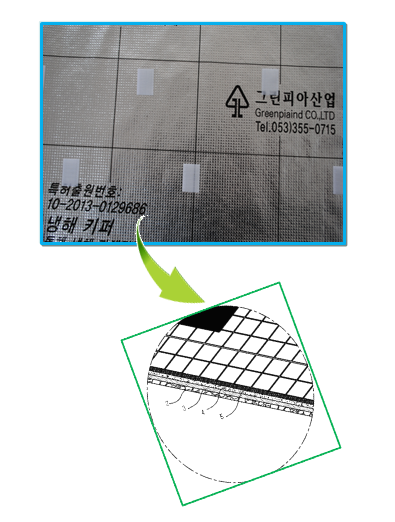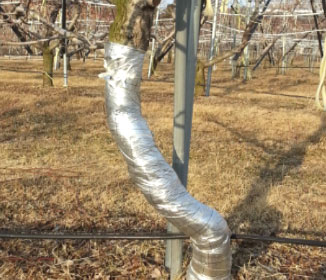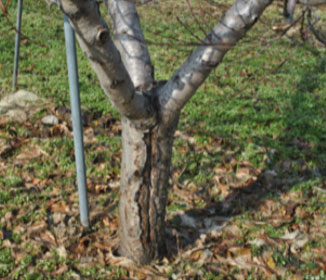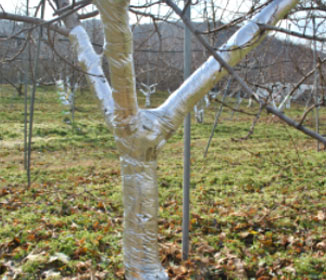Cold-injury insulation sheets
Greenpia IND / Advanced agriculture has a competitive edge
Reduced damage from cold weather conditions or frost
by using the cold-injury insulation sheets
The sheets reduce the damage from cold weather conditions or frost by decreasing temperature differences between day and night.
Velcro (also known as Sticky fabric) is a highly efficient material that is finished simply. In addition, it is so durable that it can be used for many years by keeping out direct sunlight and wind.

Product Composition
Composition: Velcro + PET film + AL-FOIL + PE coating + PU100
- Velcro (also known as Sticky fabric)
Unevenness in the size and shape of trees is overcome - PU100 (Polyurethane): Adhesion of velcro is improved
Does not get wet easily and water drops fall off rapidly.
Excellent in thermokeeping - PE coating: Improved adhesion between PU fabric and aluminum foil
- AL-FOIL (aluminum foil): Small square wrinkles prevent wrinkles
Protection from direct sunlight and wind - PET film: Prevention of wrinkles and contamination.
- Resistant to sunlight and it can be used for years.

Size and specifications of insulation sheets
Frost limit temperature of fruit trees
| fruit | Average annual temperatures | Temperatures at which it is damaged by frost | Cultivation areas |
| Apple |
8 ~ 11℃ |
-30 ~ – 30℃ |
Whole country |
| Apricot | 11 ~ 15 ℃ | -30 ℃ | Whole country |
| Pear | 12 ~ 15 ℃ | -25 ~ -30 ℃ | Whole country |
| Blueberry | 8.7 ~ 15 ℃ | -29 ℃ | Whole country |
| Plum | 12 ~ 15 ℃ | -28 ℃ | Whole country |
| Walnut | 11 ~ 13 ℃ | -23 ℃ | Whole country |
| Grape | 11 ~ 15 ℃ | American : -20℃
European : -13℃ |
Areas south of Gyeonggi province, south Jeolla province |
| Fruit | Average annual temperatures | Temperatures at which it is damaged by frost | Cultivation areas |
| Peach |
12 ~ 15℃ |
-15 ~ – 20℃ |
South Gyeonggi province |
| Plum | 12 ~ 15 ℃ | -20 ℃ | South Gyeonggi province |
| Mandarine | 15 ~ 16 ℃ | -7 ℃ | Jeju island |
| Half sweet persimmons | 12 ~ 15 ℃ | -17 ℃ | South Gyeongsang and Jeolla province |
| Sweet persimmons | 13 ~ 15 ℃ | -14 ℃ | South Gyeongsang and Jeolla province, east eastern coast of North Gyeongsang province |
| Citron | 15 ℃ | -9 ℃ | Southern coast of Korea |
Relationship between physiological activities of trees and frost
Nutrients produced by leaves change their form from starch to sugars during winter. Saved nutrients play an important role in cold resistance and are related to flower buds.
Respiratory metabolism in crowns and stems rarely occurs during winter, but if temperatures become abnormally high and then rapidly go down, frost damage is caused due to moving sap to stem.
Onset conditions of cold weather and frost damage
When trees fail to accumulate sufficient nutrients due to overgrowth, heavy fruiting, early defoliation, etc.
When the temperatures are extremely low for more than eight hours (below the limit temperature for each crop)
When the frozen moisture inside the main stem melts rapidly from February to March
When there are great temperature differences between day and night (which causes melting and freezing)
When it is acclivous rather than flat
When it is windy
When the drainage is poor or it is too dry
When disease resistance is weakened due to the lack of disease control
Time of onset and causes of outbreak
Apple Tree
1. When leaves start falling after autumn, apple trees store most of its nutrients and moisture in their roots to survive the winter. At this point in time, they can endure up to minus 30℃, and thus it is rare that apple trees freeze to death.
2. It’s when the trees begin to move sap through phloem from their roots through phloem tissues from the beginning of February that problems arise.
3. The steady and gradual movement of sap from roots to stems causes dormant trees to be out of hibernation and start sprouting, but when daytime temperature goes up and nighttime temperature goes below zero, the movement of sap in the phloem tissues become unbalanced, and in most cases, sap melts during day and freezes at night, which causes cold weather damage.
4. This phenomenon is much worse in the southern part where trees get most sunlight, and it can be said that it is caused by differences in sunlight and temperatures. In order to improve this, it is necessary to prevent sudden temperature changes as much as possible and to keep out winds which affect temperature.
5. When these conditions are maintained, steady movement of sap in the phloem and normal physiological activities are guaranteed to occur, so healthy growth can be expected.
* Hongro in M9 rootstock, especially, is badly damaged. It is because it is shallow-rooted, which means that its roots are not deep-rooted but near the earth, and their roots are smaller compared to other rootstocks, and the movement of sap is faster.
Peach trees
1. It is said that peach trees are resistant to cold and can endure low temperatures from minus 20℃to minus 25℃. However, thorough preparation is needed due to differences in dormancy period and parts, and stored nutrients. The cold resistance is weak at the beginning of dormancy, but it becomes very strong in the center, and is rapidly weakened at the end in early spring, which is the latter part of dormancy period
2. They become vulnerable to cold due to temperature difference between day and night, heavy fruiting, and early defoliation, all of which cause insufficient accumulation of nutrients.
3. Frost damage by parts
– Frost damage of xylem – Frost damage of branches – Frost damage of stems – Frost damage of trunk – Withering during winter – Withering of branches – Withering of embryo
4. According to the survey on frost damage, there are considerable variations by parts; when it comes to roots, they are exposed to frost damage from minus 15℃ to minus 10℃, to parenchyma, minus 15℃, minus 10℃ to flower buds and minus 15℃ to leaves.
In addition to this, it is impossible to prevent frost damage by 100% due to variables such as stored nutrients and environment. However, the prevention of sudden temperature changes by keeping out wind and light will help to prevent frost in the early and late stages of dormancy, and especially, it effectively keeps barks of the trees from freezing. Thus, it can inhibit the occurrence of diseases such as canker.
Preventive Measures
Covering trunks with insulation sheets helps to reduce temperature differences between day and night, protect trees from direct sunlight and cold and dry winds and moisture.
It also allows trees to grow well with proper fertilization and by balancing fruit setting.
It prevents early defoliation by thorough disease and insect pest control.
In times of severe drought during autumn, supply enough water after harvest before leaves fall.
When trees are weak, apply fertilizers, seaweeds, or sugars so that more moisture and nutrients can be supplied to roots.
Example of use
Apple Tree

Flat Type

Roll Type
Peach Tree

Before Work

After Work


벨크로(일명:찍찍이) 처리로 한번작업으로 마무리 되는 효율성이 뛰어난 자재이다. 또한 배수, 직사광선 차단, 바람차단 등 다년간 사용할 수 있는 내구성이 뛰어난 자재이다.

냉해키퍼 구성
구성 : 벨크로 + PET 필름 + AL- FOIL + PE 코팅 + PU100
- 벨크로 원단(일명 :찍찍이)
나무의 크기 및 형태의 불균일성 극복 - PU100(폴리우레탄) : 벨크로 원단의 접착성 향상.
물이 잘 묻지 않고 빠르게 흘러내림.
보온성이 뛰어남 - PE코팅 : PU 원단 과 알루미늄 호일 과 의 접착성 향상
- AL-FOIL(알루미늄 호일) :작은 사각형 주름으로 구김방지
직사광선 차단 및 바람으로 부터 보호 - PET 필름 :구김방지 및 오염 방지.
햇빛에 강하여 다년간 사용 가능

냉해키퍼 규격 및 사양
과수의 동해 한계온도
| 종류 | 연평균기온 | 동해온도 | 재배지역 |
사과 |
8 ~ 11℃ |
-30 ~ – 30℃ |
전국 |
| 살구 | 11 ~ 15 ℃ | -30 ℃ | 전국 |
| 배나무 | 12 ~ 15 ℃ | -25 ~ -30 ℃ | 전국 |
| 블루베리 | 8.7 ~ 15 ℃ | -29 ℃ | 전국 |
| 자두 | 12 ~ 15 ℃ | -28 ℃ | 전국 |
| 호두 | 11 ~ 13 ℃ | -23 ℃ | 전국 |
| 포도 | 11 ~ 15 ℃ | 미국종 : -20℃ 유럽종 : -13℃ |
경기 이남 경,전남 |
| 종류 | 연평균기온 | 동해온도 | 재배지역 |
복숭아 |
12 ~ 15℃ |
-15 ~ – 20℃ |
경기 이남 |
| 매실 | 12 ~ 15 ℃ | -20 ℃ | 경기 이남 |
| 감귤 | 15 ~ 16 ℃ | -7 ℃ | 제주도 |
| 불완전 단감 | 12 ~ 15 ℃ | -17 ℃ | 영,호남 |
| 단감 | 13 ~ 15 ℃ | -14 ℃ | 경, 전남 경북 동해안 |
| 유자 | 15 ℃ | -9 ℃ | 남해안 |
겨울철 동해의 수체생리 관계
수체 생리상 겨울이 접어들면 잎에서 형성된 양분은 녹말형태에서 당의 형태로 전환된다.
저장된 당류는 내한성에 중요한 역할을 하며 꽃눈에도 관련한다.
관부 및 줄기의 대사 호흡은 겨울에는 거의 이루어 지지 않으나, 만약 이상 고온과 한파가 교차적으로 발생하여 대사호흡이 이루어질 경우 체관부로 수액이 이동하게 되어 동해 피해가 나타난다.
냉해 및 동해의 발생조건
나무가 웃자라거나 과다결실,조기 낙엽 등으로 저장 양분 축적이 적을 때
극심한 저온이 8시간 이상 일 때(작물 별 한계 온도 이하일 때)
겨울철 원줄기 내부의 수분이 얼고 난 후 2~3월경 빠르게 녹을 때
낮과 밤의 일교차가 심할 때(녹는 것 과 어는 것이 반복될 때)
평지 보다 경사지일 때
바람이 많거나 센 지역일 때
배수가 불량 하거나 지나치게 건조할 때
병해충 방제가 소홀하여 내병성이 약해질 때
발병 시기 및 원인
사과
- 사과는 가을이 지나고 낙엽이 지기 시작하면 한겨울을 견디기 위해 영양분과 수분을 뿌리로 상당부분 저장한다. 이때는 영하 30도 까지도 동해에 견딜수 있으며 그리고 한겨울 사과나무가 얼어서 고사하는 경우는 드물다.
- 문제는 2월 초순 부터 나무가 뿌리에서 체관부를 통한 수액 이동이 시작될 때 발생한다.
- 뿌리에서 줄기로 꾸준하고 점진적인 수액의 이동이 일어나서 휴면을 깨우고 활성도를 높여야 하는데, 낮 온도 가 상승하고 야간온도는 영하로 떨어져 버리면 체관부 수액 이동의 불균형이 일어나고 상당수 낮에는 녹아서 활성화 되다가 밤에는 얼어버려 냉해 피해를 입는 경우도 많은 편이다.
- 이런 현상은 빛이 받는 남쪽이 훨씬 심한데 빛 의 유무 와 온도 편차로 벌어지는 현상 이라고 할 수 있다. 이를 개선하기 위해서는 급격한 온도의 변화를 최대한 차단 하고 온도에 영향을 미치는 바람을 차단 할 수 있게 하여야 한다.
- 이런 상태를 유지 할 때 꾸준한 체관부 수액 이동이 일어 나며 생리 활성도 정상적으로 유지 되어 건전한 생육을 바랄 수 있다.
* 특히 M9 대목의 홍로의 경우는 피해가 심하다.
그 이유는 뿌리가 지표면 인근에 퍼져있는 천근성 이며, 다른 대목에 비교해 뿌리의 양이적고 수체 의 이동이 빠르기 때문에 그 피해가 더욱 심하다.
복숭아
- 복숭아의 내한성은 영하 20도 ~ 영하 25도로 저온에서 잘 견디는 것으로 나와있다.
하지만 휴면기간과 부위, 저장양분 등에 다른 차이가 커서 세밀한 대비가 필요하다. 휴면초기에는 내한성이 약하다가 중기에는 대단히 강하며, 이른봄의 휴면후기에는 내한성이 급격히 약해지는 특성이 있다. - 급격한 일교차와 과다결실, 조기낙엽의 경우 저장양분 축적부족 (특히양분) 으로 내한성에 취약 해 진다.
- 부위별 동해
– 목질부 동해 – 분지부 동해 – 지정부 동해 – 원줄기 동해
– 동기의 일소 – 가지의 고사 – 눈의 고사 - 동해율 조사 집계에 따르면 공식적인 내한 온도와는 다르게 부위별로 상당한 편차를 보이는데 뿌리의 경우 휴면기에 -15도~-10도에 동해를 받으며 유조 직목부의 경우 -15도, 화아의경우 -10도, 엽아의 경우 -15도에서 동해를 입는 것으로 나타난다.
이뿐만 아니라 저장양분, 환경까지 겹쳐있어 100% 동해의 예방은 불가능하다. 하지만, 바람과 빛의 차단을 통해 급격한 온도변화를 방지하는것 만으로도 휴면초기, 후기의 동해 에방에 도움이 되며, 특히 수피 동결이 되어 목부로 부터 분리되는 경우를 예방하는 효과는 크다고 할 수 있다. 이로 인한 동고병 등의 발생억제를 할 수 있다.
예방 및 대책
냉해키퍼로 원줄기를 감아주어 주간과 야간온도 편차를 줄이고 직사광선 및 차고 건조한 바람, 수분으로부터 보호한다.
알맞은 시비 와 착과 량 조절 등으로 건전한 수세를 유지한다.
철저한 병해충 방제로 조기 낙엽을 방지 한다.
가을 가뭄이 심할 때는 수확 후 낙엽이 지기 전에 충분한 수분을 공급한다.
나무의 세력이 약할 때는 해조류나 당 또는 비료를 수확 후 낙엽이 지기 전 살포하여 뿌리로 좀 더 많은 수분과 양분이 공급 될 수 있게 한다.
사용 모습
냉해키퍼 사용예 (사과)

평면타입

롤타입
냉해키퍼 사용예 (복숭아)

작업 전


